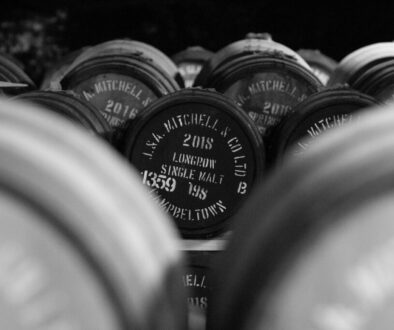
Rosebank whisky has many dedicated fans, thanks to its rounded and fruity palate and cult status. This lowland distillery closed its doors in 1993 and most of the equipment, including the stills and mash tun, was stolen in 2008. The distillery sat mothballed for many years, but current owners Ian Macleod Distillers plan to give Rosebank a new lease of life.
Rosebank to Return
After the mash tun and stills were burgled in 2008, the remaining maltings were converted into a Beefeater restaurant. Historical buildings still remain alongside the Forth & Clyde Canal – these buildings will be restored. These buildings will be saved and reused as a visitors centre, a tasting bar, a cafe, a shop, and an exhibition space. The only surviving piece of equipment from the distillery is the mill, bought from Port Ellen in the 1930s.
The refurbishment will cost up to £12 million, and Falkirk council approved the plans in 2018. Rosebank used a combination of worm tub condensers and triple distillation to create their unique whisky, a whisky that is soon to be reawakened and rediscovered using the same methods of distilling that Rosebank used before its closure.
Early estimates predicted that Rosebank would be operational by late 2019. These predictions were very generous, and in the current situation, it is looking more likely that Rosebank will be up and running by late 2020.
This new Rosebank will have the capacity to hold 1 million litres of whisky, but will not release any young whiskies, only releasing casks when the time is right – after about 10 years of maturation.
Ian Macleod hopes that the new Rosebank will attract over 50,000 visitors a year and that the site will prosper once more.
Send me my free cask buying guide
The History of Rosebank
Named for the roses which grew on the banks of the Forth & Clyde Canal at Camelon where this distillery was located, the Rosebank Distillery has a history which quite possibly dates back to the end of the 18th century.
From existing records, a distillery has been shown to have been in existence in Falkirk in 1798 – an operation which was operated by the Stark brothers. A distillery has been shown to have been opened in 1817 which went by the name of Rosebank by a James Robertson, however, it is unknown if both were on the same site, and in any event, the Rosebank distillery closed within two years. John Stark opened the Camelon distillery 10 years later and ran its operations until he died in 1836.
It was then run by the Gunn family until 1840 when James Rankine approached them with a view to leasing or buying the Maltings distillery on the canal’s east bank where he then established a brand-new Rosebank distillery. This new incarnation of the distillery grew rapidly, and due to demand, it was expanded in 1845 and then rebuilt completely during 1864. In 1861, the Camelon Distillery went out of business due to bankruptcy, and Rankine bought this site too, deciding to demolish it and use its maltings for the Rosebank distillery’s purposes.
In 1914, the Rosebank Distillery Ltd was one of the companies which joined the amalgamation to become the Scottish Malt Distillers. Although Rosebank was popularly considered to be a premier lowland whisky, the distillery was mothballed in 1993 since it required an upgrade that would cost £2 million to make it compliant with the European standards.
In 2002, the contents and buildings of the distillery were bought by British Waterways, with the maltings then being demolished in order to build houses. Although in 2008 plans were begun to use the original Rosebank equipment to open a brand-new Falkirk distillery, unfortunately, the original stills and other equipment were stolen and while the new building went ahead, the Rosebank trademark was not released for the new distillery to use.
The Rosebank name was finally acquired by the Ian Macleod Distillers in 2017 and the site was also purchased from Scottish Canals with a plan to re-establish the Rosebank Whisky name through the construction of a new distillery so that production could once more be commenced in the traditional style.












